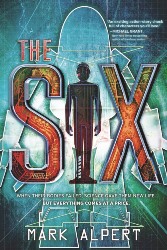2018 School Spending Survey Report
The Thrilling Possibilities of AI and YA Sci-Fi: Mark Alpert on "The Six"
Mark Alpert, contributing editor at Scientific American, explores the definition of humanity, the cost and benefits of scientific research, and teen angst in his debut YA novel, The Six.

Photo by Don Pollard
Mark Alpert, contributing editor at Scientific American, explores the definition of humanity, the cost and benefits of scientific research, and teen angst in his debut YA novel, The Six (Sourcebooks, 2015). A longtime journalist and author of several adult thrillers, Alpert pits Adam, the main character, and five other teens with fatal illnesses, now inhabiting superpowered robots, against an Artificial Intelligent (AI) experiment gone rogue in this fast-paced sci-fi offering for teen readers. What inspired you to write The Six? I was fascinated by scientists’ effort to completely map and scan the brain. What if this actually works? Could you put it in a computer and reproduce a person’s personality? I was also thinking about how I could integrate the flip side of the Singularity theory [popularized by Ray Kurzweil, a futurist who posits that in the near future robots will become sentient and will overtake human thinking]. What if we could introduce human elements into machines? Teens struggle with the ideas of “Who am I?” and “What am I?” every day. Imagine if we were able to add a teen’s thoughts into a machine. They would be asking, “Would it be a copy of me or the real me?” Also, it’s important that kids be exposed to STEM education at an early age. If teens are not involved in science and mathematical thinking in their teen years, they never will be. The human brain at 13 and 14 years old is capable of trillions of connections. There’s an incredible pruning that occurs after the adolescent years, in which the connections that you’re not using are lost, and the brain will then only focus on the connections you’ve been using. Your brain becomes less flexible as you get older. My teenagers get a lot of homework, and there isn’t much opportunity for leisure reading. Or they get distracted by video games. I wanted to write a book that would get reluctant readers interested in neuroscience and that would provide the same excitement that kids could get from playing Halo. I’m trying to convey this excitement about science through this book. And hopefully, they’ll take it further. Even though this is an action-packed, sci-fi YA novel, some deep themes about human nature and the importance of life itself are explored here. How did you balance these ideas while writing the high-octane plot? As a reader, I like jumping back and forth between action and themes—having moments in which characters can regroup and catch a breath. I also want to introduce ideas that teens might find irresistible. I, Robot by Isaac Asimov and Michael Crichton’s The Andromeda Strain () did that for me as a teen. There would be long sections in between the action in which the authors would discuss topics such as the history of civilization—it made me think. For me, it was a matter of balance. When I sensed that it was time for a break in the action, I would add some philosophical ideas. It was part of the fun of writing this story. I wanted to explore questions, such as, “What does gender mean when you don’t have a human body?” and, “Can you have boyfriend/girlfriend relationship when you’re in a metal container?” What are other examples of “real science” that you included in this title? Neuromorphic circuits—it’s a real thing. In 2013, the White House set aside funds for the BRAIN initiative—a project to study the brain and unlock the mysteries of the mind. Scientists are working to develop new technology to map the brain and be able to see it at a cellular level. The best that we have now is MRI. Your brain contains 100 billion nerve cells and connections. Scientists believe that our memories and character traits are somehow encoded in the neurons. They’ve noticed that when we remember things, those connections change. The belief is that all that makes a human can be found in those connections. IBM is working on developing chips that mimic that process. In the book, Adam’s dad has been able to discover how to do this and is able to inject the teens’ memories and personalities into the giant superpowered robots. Who are some of your favorite authors? Michael Crichton’s The Terminal Man (Knopf, 1972) is one of the first sci-fi thriller books I loved. The book is about the dangers and incredible potential of connecting machines with humans. Frank Herbert’s “Dune” series was also a favorite. Teens are probably not familiar with Vernor Vinge, but he’s big in the science fiction community and he writes amazing books about the galaxy. They inspired me to major in astrophysics in college. Though this work is science fiction, do you think a “robot revolution” or upheaval by AI is possible in the near future? I think it’s bound to happen. IBM's Watson, an AI, defeated the two best Jeopardy! champions a few years ago. I went to the IBM lab in Yorktown, NY, as part of my research for this book, and it was like a playground. I interviewed David Ferrucci, the man behind the algorithm that answered all of those Jeopardy! questions. There’s already a profusion of work in this section of technology. Teens from all over the world are currently designing robots to do things that only humans can do. There’s so much work going on in this area that it’s inevitable one day machines will not only do what we can do but even do it much better than we can. A lot of futurist thinkers are already discussing ways to reconfigure software and trying to program “friendliness” into machines. Teens today will most likely be the ones who will see this happen. They will be making the tough decisions later. Is there a character that you most identify with? Which is your favorite? I identify most with Adam’s father. Adam complains about his father worrying about him and of course, as a father myself, I am very concerned as well. I also remember what it was like to feel like an outsider. Adam feels incredibly isolated because of his illness and would rather spend time in his virtual reality game. I remember feeling like I was living in my own fantasy world and having crazy dreams about what could be possible in the future. Now, Adam is acting that out. It’s one of the reasons I chose teens as the heroes of this book. It’s the time of life in which so much is opening up. They’re beginning to develop adult powers. It’s no coincidence that there are so many YA books about superpowers. It’s a metaphor for growing up—having a sense of the daunting adventure of life. What are you working on next? I’m currently writing the sequel to The Six, which ends in a cliff-hanger. SIGMA [the AI that the protagonist’s father created, which is trying to vanquish humanity] is still out there. I’m interested in developing the characters more. I’m also writing another adult thriller for St. Martin’s Press.
Who are some of your favorite authors? Michael Crichton’s The Terminal Man (Knopf, 1972) is one of the first sci-fi thriller books I loved. The book is about the dangers and incredible potential of connecting machines with humans. Frank Herbert’s “Dune” series was also a favorite. Teens are probably not familiar with Vernor Vinge, but he’s big in the science fiction community and he writes amazing books about the galaxy. They inspired me to major in astrophysics in college. Though this work is science fiction, do you think a “robot revolution” or upheaval by AI is possible in the near future? I think it’s bound to happen. IBM's Watson, an AI, defeated the two best Jeopardy! champions a few years ago. I went to the IBM lab in Yorktown, NY, as part of my research for this book, and it was like a playground. I interviewed David Ferrucci, the man behind the algorithm that answered all of those Jeopardy! questions. There’s already a profusion of work in this section of technology. Teens from all over the world are currently designing robots to do things that only humans can do. There’s so much work going on in this area that it’s inevitable one day machines will not only do what we can do but even do it much better than we can. A lot of futurist thinkers are already discussing ways to reconfigure software and trying to program “friendliness” into machines. Teens today will most likely be the ones who will see this happen. They will be making the tough decisions later. Is there a character that you most identify with? Which is your favorite? I identify most with Adam’s father. Adam complains about his father worrying about him and of course, as a father myself, I am very concerned as well. I also remember what it was like to feel like an outsider. Adam feels incredibly isolated because of his illness and would rather spend time in his virtual reality game. I remember feeling like I was living in my own fantasy world and having crazy dreams about what could be possible in the future. Now, Adam is acting that out. It’s one of the reasons I chose teens as the heroes of this book. It’s the time of life in which so much is opening up. They’re beginning to develop adult powers. It’s no coincidence that there are so many YA books about superpowers. It’s a metaphor for growing up—having a sense of the daunting adventure of life. What are you working on next? I’m currently writing the sequel to The Six, which ends in a cliff-hanger. SIGMA [the AI that the protagonist’s father created, which is trying to vanquish humanity] is still out there. I’m interested in developing the characters more. I’m also writing another adult thriller for St. Martin’s Press. RELATED
RECOMMENDED
CAREERS
The job outlook in 2030: Librarians will be in demand
CAREERS
The job outlook in 2030: Librarians will be in demand
ALREADY A SUBSCRIBER? LOG IN
We are currently offering this content for free. Sign up now to activate your personal profile, where you can save articles for future viewing






Add Comment :-
Be the first reader to comment.
Comment Policy:
Comment should not be empty !!!